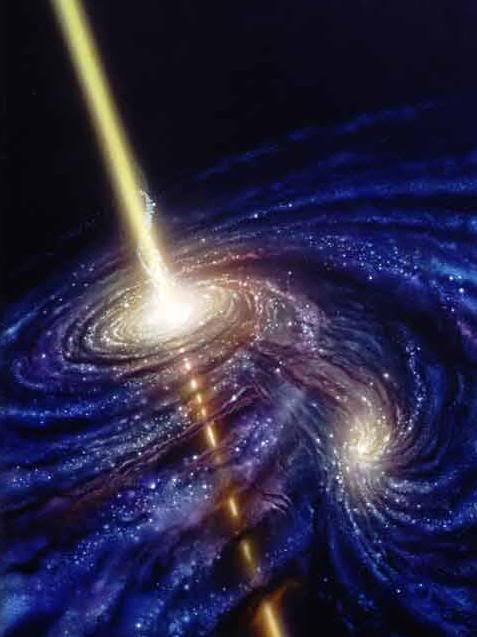
Just when the war against the Mother was looking its bleakest and it appeared life would be snuffed out forever, the sun burst forward and released its rays on the entirety of existence. The image we are meant to see in our minds is a great lion roaring, and the darkness dissipating to the edges. He is often portrayed as a beautiful young man with golden hair, riding a chariot and carrying a lyre, and was Apollo to the Greeks, Krishna to the Indians, and when he returned midway through the great story, Jesus to the Christians. With his rational insight glowing from his forehead, "he pushe[d] back the darkness until it becom[e] like a giant dragon or serpent encircling the cosmos" (Booth 72). By roaring from his leonine lungs, the Mother became impregnated in her 'cosmic womb' from his shout. Matter starts to bead, to come together into planets, moons, asteroids, and slowly plant life. The massive spinning mists harden. He literally sings the world into being.
This story, according the secret schools, is the transformation of the mineral to the plant consciousness. As green life began spreading over the face of the earth, death was nonexistent--plants thrive by being pruned, by receding each year and coming back the next. And this "vast vegetable being at the heart of the cosmos, whose soft and luminous limbs stretched to all four corners of it, was Adam. This was paradise" (73). When we commune with nature, as Montanans are often prone to do, we are returning to the state before animal consciousness and ego. It is a more peaceful world, or at least one where the cycles of life and death appear to be an illusion. "Because there was as yet no animal element to the cosmos, Adam was without desire and so without care of dissatisfaction. Needs were satisfied before they could even be felt. Adam lived in a world of endless springtime. Nature yielded an unending supply of food in the form of a milky sap, similar to that which we find in dandelions today. Memorials to this blissful satiation have come down to us in statures of the many-breasted Mother Goddess" (74). This plant consciousness continues to exist and is often referred to as the subconscious. If you were to see a diagram of the nervous system, it would look very much like a tree.
The 'third eye' is often understood to be the pineal gland in the front center of the brain behind where the forehead is. Many animals, including some lizards, frogs, and lampreys, maintain a small eye here, capable of detecting rays of light. Chakras are often thought of as New Age mumbo-jumbo but were depicted across the ancient world. The horns on Moses', which many understand as a mistranslation, could "represent the two petals of the brow chakra" (Booth 77), and the pictures of Pharaohs with a snake on their helmets relate to the pineal gland as well. The pine-cones atop Dionysian wands and the staff of Aaron are sometimes interpreted as enlivening the forehead chakra. The third eye was man's connection with the spiritual realms (sometimes described as a sphincter) and sits between both the left and right brains. It regulates the hormone, melatonin or DMT, a drug which can cause hallucinations, or experiences beyond the normal range of perceptions. This eye is one of the most important symbols as relating to the overcoming of the monstrous being of Saturn and the holistic, sometimes fickle Mother. It is here where you can utilize both sides of the warring parents, and the realm of the dying-gods, specifically Apollo/Dionysus, the twin deity--the first half is accepted by our modern world, but the second half is repressed. The eye is also the place where our mind makes sense of the universe. The swirling mist gains geometry only when we perceive it as such. Like Schrodinger's Cat, there would be no one there to give mass shape or coherence. We create the universe by observing it.
I shall come back to this, but first I want to briefly explore the next stage of consciousness' development: Adam's temptation. This is the final part of the three-part act during ancient initiation rights.
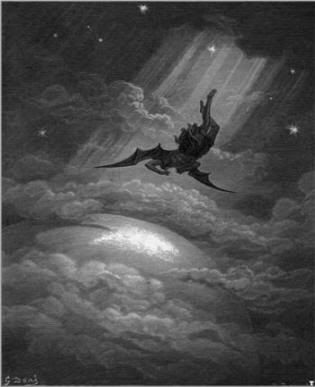
Lucifer, the morning star, is the animal consciousness, which gave birth to the ego. He is a necessary evil and quite separate from Saturn/Satan. His image is of the snake wrapped around the tree and represents the spinal chord forming, of plants becoming animals. In Shlain's The Alphabet Versus the Goddess he describes how women became increasingly sexualized through homo sapiens' development and could produce offspring anytime as a way of getting men to protect and help raise the children. Other mammals are fertile only a few times a year with males interested in procreation during this period alone. Chimp society is formed this way but women overcame this. Sex for them became a continuous bargaining tool. Women, by becoming increasingly dependent on mans' hunting, are what caused his domestication. Thus did Adam and Eve perceive themselves as being naked. Snakes are linked to women, as readers of Genesis will know. The snake appears to eternally renew itself by shedding its skin, it crawls along the earth on its belly, and its body has similarities to the umbilical chord. Shlain mentions that a woman appears serpentine during intercourse, opposite of the man's awkward thrusting.
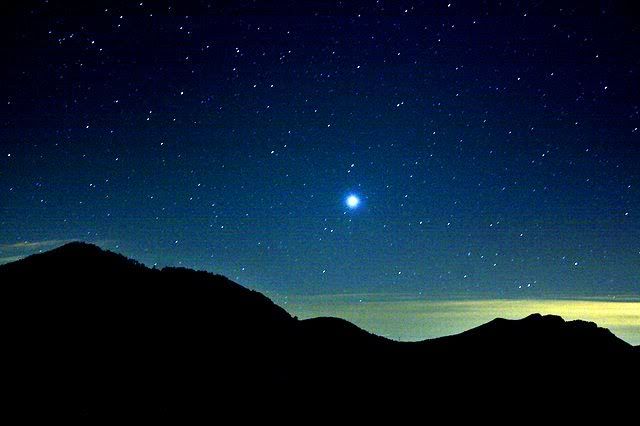
In the esoteric tradition, Lucifer is Venus. One only needs to look at the morning star to confirm this.
These associations are an important aspect in the next few myths I will explore--the relationship between men and women. In these tales, the woman takes the forefront. This was the result of the agricultural societies. These myths are very different than the sky gods of the Paleolithic period. Death was seen as an illusion, and gods' stories became increasingly more complex. However, these stories were rationality developed, and the images created during the time are still commonly represented across our modern cities.
2. Osiris, Horus, and Adonis

The dying gods are at the heart of many religions and esoteric ideas. The sun represents compassion, truth, and love. It shines its light upon on all our heads, brightening the Earth, saving the world from the darkness of night, breathing life into every tree, bush, and weed, every mouse, shark, and elephant, and every human. In the body, it is the heart organ, pulsing blood to the rest, saving the rest, just like Jesus shed his blood on the cross. One day, sages say, he will return, and the Goddess and the Sun will be reunited once again. In Syria, he was Baal and Tummuz. In Babylon, he was Dummuzi. In Greece, he was Adonis, Apollo, and Dionysus. In Iran, he was Mithras. In Rome, he was Attis. To the Masons, he is Hiram Abiff. And to the Christians, he is Jesus Christ, the savior of the world. In this essay, I will focus most of my attention on the Egyptian Osiris/Horus and Apollo/Dionysus. The myth of Osiris, Horus, Set, Isis, and Nephtys is not a backwards myth, with deities worshiped by a backwards people, dead and incompatible with our modern reality. In fact, it is built into the Great Seal of the United States. The Great Eye of Horus is on all our dollar bills. It shines true, above all petty human concerns, above prejudices, hate, and discrimination. The founders saw themselves as being on top, where the capstone would be, observing the world from a purely rational mind-state. Many researchers have examined the esoteric lay out of the capital. With its grand obelisks drawing energy down to earth, enlivening the Washington Monument where the cock magically ejaculates, and the spiritual semen is jettisoned across the reflecting pool and impregnates the great Capital building dome--an ancient representation of the womb. Every day, the sun rises, and every day, Horus is conceived. Even the number 13 is magical. Twelve is the number of disciples Jesus had, so Jesus was number 13--the God who resurrects. To explore these themes more deeply, we are going to have to examine the myth of Osiris.
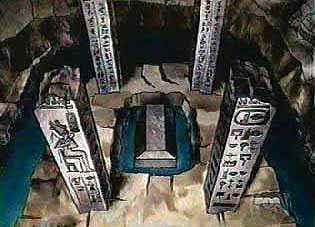
The Egyptians believed that their kingdom was once led by Osiris during a golden age. Herodotus, the early Greek historian, claims that his grave was decorated with huge stone obelisks as well as a man-made lake. "It is on this lake" he says, "that the Egyptians act out the Mysteries, the Black Rite that celebrates the death and resurrection of a being whose name I dare not speak. I know what goes on but ... say no more." If that is not intriguing, ala H.P. Lovecraft, I don't know what is. I found a post on a website who's author believes that the god's tomb is 100 feet below the Sphinx. Of course this is quite speculative in a conspiratorial sort of way, but it does go to prove how serious people take this god in his corporeality. Osiris' name is connected with reproduction, ('ourien' means semen), and some claim he is the same as the Greek Orion and biblical Nimrod (perhaps stretching even to Gilgamesh). His tale is one of betrayal, resurrection, and Mother Goddess worship. Like Baal and Dummuzi, he dies and is resurrected--like the sun dies every night and comes back in the morning, and like the winter kills life and spring brings it back. Like Dionysus, he also has a polar opposite in his brother Seth.
Brother battles reoccur in stories across history, notably Shakespeare--they show duality in pairs. Seth's name links him to Saturn/Satan. His motives for wanting to kill his brother are hazy. Was he jealous? Did he catch Osiris cheating with Nephtys? At any rate, after a gala, Seth tricks his brother into a coffin. After discovering the perfect fit, he seals Osiris inside, covering it with molten lead and throws it in a river. Osiris' sister/lover, Isis, is so distraught by his death that she searches for him across the ancient world, eventually finding him encased inside a tamarisk tree. She, being an amazing god, resurrects him, but Seth quickly discovers this miracle and chops the revived king into 14 pieces anew. Again, Isis finds all her husband's parts in the Nile--except for his penis, which was eaten by a crocodile. However, she manages to impregnate herself with an ersatz recreation and gives birth to Horus, who swears revenge on his uncle. He flies to greet Seth on a flying saucer with the aid of Thoth and kills him. In the aftermath, Osiris continues to rule the underworld, weighing the dead's deeds and granting them access to his kingdom if they weren't found lacking, while Horus was the king of the living. "The myth of Osiris," according to Mark Booth, "has many layers of meaning, but it is above all a myth about consciousness. It informs us that we must all die--but in order to be reborn. The key point in this story is that Osiris is reborn not into ordinary life, but into a higher state of consciousness" (131). Plato's realm of sphere's and imperfect shadow realities are reflected in what Booth says here. "'I shall not decay,' [Osiris] proclaims in the Book of the Dead, 'I shall not rot, I shall not putrefy, I shall not turn into worms, I shall have my being, I shall live, I shall live'" (131).
The Greeks, I believe, saw their Osiris as a dual entity (Apollo and Dionysus), and I will relate this in more detail in the subsequent paragraphs. However, there was another archetype in the Hellenistic world which also fit this theme. Tales arrived from Syria in the story of Adonis, the place where he was conceived. Adonai, another dying god who symbolizes cycles, literally means 'lord. In some stories, after much bickering, Adonis spends one-third of the year with Persephone in Hades, and two-thirds with Aphrodite, as a metaphor for the seasons. However, the most famous account deals with Adonis' death. Aphrodite, the mother god in this case, falls very much in love with the beautiful young man until he is gored and killed by a wild boar, sent by various goddesses in different accounts. Upon his death, Aphrodite sprinkles his blood with nectar and an anemone blossoms. In Shakespeare's version, she places the flower between her breasts and weeps her loss. When Ted Hughes analyzed the bard's choice of subject, he sees the boar as a destructive force which appears time after time in his works. I would argue that the creature is a force of Saturn, again trying to wreak havoc on the Mother Goddess.
3. Apollo/Dionysus
The Greeks knew that the Egyptian Osiris had parallels with their own gods, and some translated Dionysus and Osiris as being one and the same. In one tale, Dionysus flees from Greece and disguises himself in Egypt as Osiris.
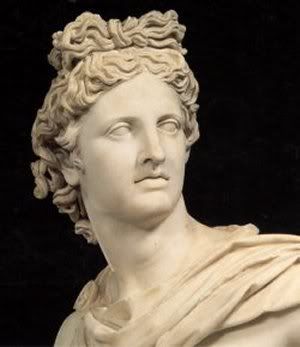
But where does Apollo fit in? Apollo is the god of laws, construction, language, and wisdom, which seems somewhat opposed to the other solar deities. Zeus' favorite son, he plays the lyre and his chosen weapon is the bow and arrow, because like logic, he analyses rationally from a distance. Jean Shinoda Bolen in her book on male archetypes, Gods in Everyman, explains that "Apollo personifies the aspect of the personality that wants clear definitions, is drawn to master a skill, values order and harmony, and prefers to look at the surface rather than at what underlies appearances." She continues, saying that the "Apollo archetype favors thinking over feeling, distance over closeness, objective assessment over the subjective intuition" (135). Apollo, again, symbolizes law, order, and most importantly, logos and language. Intriguingly, it was this God who killed Python, a serpent monster. Logos killed mythos. The male zeitgeist killed the female one.
Opposed to the archetype of Apollo, but ultimately completing him, is Dionysus (Bacchus to the Romans or Iachos as an infant). Bolen says that the Dionysian archetype "has powerful positive and negative potentialities, stirring up the most ethereal and the basest of feelings, creating conflicts within the psyche and with society" (255). He represents madness, the extremes, and drunkenness. At one moment he can be in the throes of ecstasy and in the next a terrible depression. Where Apollo stands at a distance with his arrows raised, Dionysus knows the truth is only in the present. There is no planning. There is no figuring out the next step in preparation for a scheme. A representation of these two opposing figures in modern pop culture is Batman and the Joker, as anyone could have guessed by Heath Ledger's incredible performance in "The Dark Knight."
Dionysus is also the persecuted god, the one who needs to be sacrificed, because the extremes exist within him--just like Jesus' arms stretched over the cross. He wishes to save the woman who he loves and will eventually place her in the role of a wife/maternal figure like his great love, Ariadne. Dionysus can drive women mad. He is needy, haughty, dangerous, moody, and fickle. He tempts them with base desires which may be hidden away because of man's dominance over them. Women, under the spirit of Dionysus, would rampage into the hills, suckling young animals and ripping to shreds any that dared to flee from their procession. This was an expression of society's pent-up aggression, an outlet for the rational god, and a need of the mad one. Dionysus' maenads tore Orpheus and King Pentheus apart in the myths. Anyone familiar with True Blood will know Dionysus' characteristics if they have watched Season 2. He is known as the "god who comes" in this exploitative HBO series, but Dionysus exists within us all. One myth tells of Dionysus being torn apart and eaten by the Titans. When Zeus discovers this, he kills the giants and makes man from their bodies. Thus, a little bit of this persecuted god is alive inside of you, whether you like it or not. Dionysus is also nomadic, having traveled east to India to study with the gurus there. In numerology he would be characterized by the number "5".
It is my belief that Apollo and Dionysus are the same god. Both represent the sun (like Osiris), and without the other, something is lost in their respective images. Once every year, Apollo was known to fly away to the Hyperborean land and leave Dionysus in charge of Delphi. This act can signify the winter cycle or the daily sleep, but it also can represent something more. We cannot be purely rational all the time. William Blake talks about balance. By trying to destroy Dionysus, he will only come back stronger when he emerges within us again. Economists call these wild tendencies "animal spirits," where unexplainable zeitgeists seem to overwhelm the minds of people and drive the markets crazy. I believe something was forgotten in our rational society: Dionysus, the need for madness which overtakes us one-fourth of every year, one-fourth of every day, and one-fourth of every hour. Nietzsche, in The Birth of Tragedy, emphasizes this trait in the works in the three great Greek play writes, saying that the ordering hero (of Apollo) is overwhelmed by chaotic fate (of Dionysus)
Dionysus is holistic like the mother. He is the god of masks, theater, and roles. As Apollo tries to construct something beautiful, the Dionysian (sublime) aspect will ultimately beg to tear it down. Apollo with his lyre would play something by Bach or Beethoven, Dionysus would be most happy at a rave, and as Apollo is the god of law and order, Dionysus is the god of the destruction of boundaries. According to the American scholar, Camille Paglia, "The quarrel between Apollo and Dionysus is the quarrel between the higher cortex and the older limbic and reptilian brains." Apollo, the god of supreme rational wisdom portrayed on our dollar bills on top of the pyramid, is logos. In his 'supreme wisdom,' he was aware that he needed Dionysus by fleeing to Hyperborea. In our modern culture, we have forgotten this. Dionysus is persecuted. Feminine characteristics are stomped out of boys in lieu of the cherished engineer Apollo, Zeus' favorite son, the Ivy League hopeful, student body president, and captain of the swim team. Economists talk about rational individuals but forget that individuals are also 'mad' one-fourth of the time.
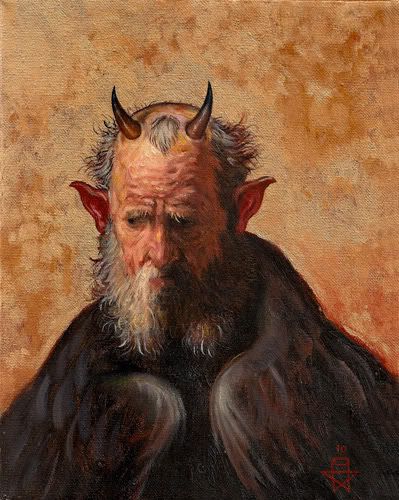
Dionysus, as an archetype, is also the remarriage of Christian and Satanic images, as discussed in this essay. In his myths, he is the god who died for man's sin many times yet always resurrects. He is associated with the vine and honoring him by a "ritual meal of bread and wine" was common in his celebrations. His father was a sky god (Zeus) and his mother a lesser moon goddess (Semele)--something we will see has parallels in esoteric knowledge--and his name has the familiar 'sus' at the end. Similar themes of both Dionysus and Jesus traveling to India and learning ancient wisdom have also emerged in the esoteric tradition.
Why are there so many similarities? Because good mythologies steal from each other and they are both in the tradition of the dying-and-rising gods which appeared across the ancient globe. Wikipedia says, "E. Kessler in a symposium Pagan Monotheism in the Roman Empire, Exeter, 17–20 July 2006, states that Dionysian cult had developed into strict monotheism by the 4th century CE; together with Mithraism and other sects the cult formed an instance of 'pagan monotheism' in direct competition with Early Christianity during Late Antiquity." Pagan cults of Dionysus and Asclepius were early competitors to Christianity. Shlain would say this monotheism was a result of literacy in both societies and probably why a god of written laws made such headway, finally overtaking ancient pagan beliefs. Dionysus, as the god of women and irrationality, was of course the god who would be ultimately banished from the collective mind. This could be a result of the two religion's early competition as well as the emergence of rational law and thought. Greece cherished Dionysus' presence. But to establish hierarchy, Rome could not have the holistic, mad god on the loose. Dionysus was often cavorting with satyrs in his myths, being helped raised by Silenus in a cave. The devil is also seen as a goat-man in imagery, with is horns, hoofs, and billy-goat-tee. He has many of the features Christians associate with the devil. Both Satan and Dionysus are also associated with women and snakes because he is the god of this world, and by attempting to extirpate him, we only make his allure greater. Modern culture's hidden desire for darkness and death can be seen as our Dionysian energies exploding out in uncontrolled ways. Logos and mythos complete each other, they are not at odds. In Game Theory, we call this a relative sum game. Both can thrive as the other does.
Some have gone as far as to proclaim that Apollo will be returning in 2012, as was predicted by several different groups as a new golden age of the gods. Tom Horn describes in his book, Apollyon Rising 2012, that "the tomb of Osiris may actually have been discovered in Giza in recent years containing DNA related to the deity" (135). This may remind people of the Lovecraft mythos, especially when esoteric mystics like Manly P. Hall proclaim in their books, "The Dying God shall rise again! The secret room in the House of the Hidden Places shall be rediscovered. The Pyramid again shall stand as the ideal emblem of solidarity, inspiration, aspiration, resurrection, and regeneration." A slightly terrifying prospect when Revelation mentions a being by the name of Abbadon, 'Apollyon'. The Cumaean Sibyl describes a new divine son, who "is to be spawned of 'a new breed of men sent down from heaven' [...] when he receives 'the life of gods, and sees Heroes with gods commingling" (137). Horn translates this as Apollo being the literal anti-Christ, son of Zeus, the pagan version of God. He describes how this spirit has reincarnated throughout the ages in different guises, most notably Napoleon, who's name translates as 'the true Apollo.' He also relates how the Pythian priestess' prophecy powers and convulsions were similar to modern day demon possessions depicted in movies like "The Exorcist". I am not sure what to make of this, though I do know that America was described as the New Atlantis by distinguished philosophers like Francis Bacon, and that the eagle on the dollar bills could very well be translated as a phoenix, an important occultic symbol. At the very least, it is interesting reading for a late night to scare yourself in the darkness. In the end, I think the dual Apollonion and Dionysian archetypes are the seat of rationality, but only when they are coupled together. It is where we need to arrive at and think through to defeat a history of wars and irrational sky father philosophy--at least in the way it is being interpreted today as sort of a death cult. In the next section, I will discuss the modern Father god, and how he came to prominence upon the invention of the alphabet.
No comments:
Post a Comment